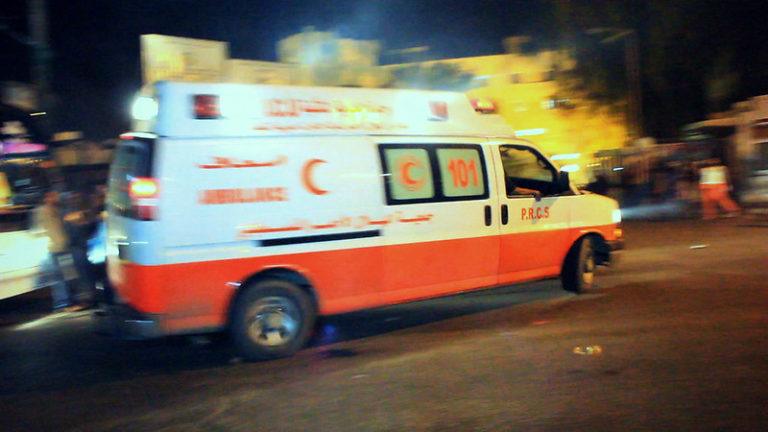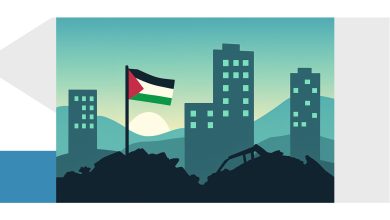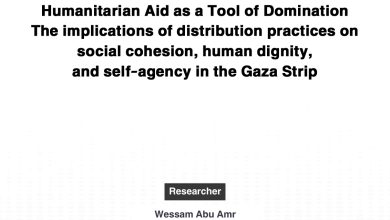Gaza’s New Conflict: COVID-19

![]() At a time when everyone was celebrating the arrival of a new decade, a rare once-in-a-100-year event took the world by surprise: a major global pandemic named COVID-19. Governments around the world struggled to fight the virus, taking extreme measures to contain it with nearly one billion people now living in confinement. At first, Palestinians followed up on the pandemic with sighs of relief thinking that the virus will never reach them, especially in Gaza, where two million people have been living under a suffocating siege for more than a decade. Alas, their worst fears have been realized: the discovery of dozens of Coronavirus cases in both the Gaza Strip and the West Bank.
At a time when everyone was celebrating the arrival of a new decade, a rare once-in-a-100-year event took the world by surprise: a major global pandemic named COVID-19. Governments around the world struggled to fight the virus, taking extreme measures to contain it with nearly one billion people now living in confinement. At first, Palestinians followed up on the pandemic with sighs of relief thinking that the virus will never reach them, especially in Gaza, where two million people have been living under a suffocating siege for more than a decade. Alas, their worst fears have been realized: the discovery of dozens of Coronavirus cases in both the Gaza Strip and the West Bank.
In 2012, The United Nations Relief and Works Agency for Palestinian Refugees warned that the Gaza Strip would be uninhabitable by 2020. Years of a devastating siege and a series of military conflicts taking the lives of thousands struck the enclave with misery and poverty, bringing youth unemployment up to 75% and the economy to its knees. The current healthcare and sanitary system in the Gaza strip are extremely exhausted, lack basic resources, equipment and material that would be necessary not only to fight a major pandemic, but to simply treat normal day-to-day patients. A major outbreak of COVID-19 in the Gaza strip would lead to nothing less than a disastrous effect and would likely cause a death toll higher than all previous military conflicts combined.
On March 26th, 2020, the United Nations announced that it would facilitate the delivery of a total 1200 COVID-19 testing kits to Gaza’s hospitals to help fight the outbreak. Nearly 1636 people who arrived in Gaza via the Rafah Crossing border or the Beit-Hanoun (Erez) checkpoint have been placed in mandatory quarantine in 22 centers around the Gaza Strip, including schools, hotels and healthcare centers. 505 more people are currently in confinement at home. In the Gaza strip, every individual has an average of 0.18 square meters of personal space, which would place Gazans into involuntary clusters of interconnected social networks. One person can easily transmit the disease to scores of family members and neighbors living nearby, in houses that are glued side by side to each other. At one of the most densely populated areas in the world, the average family has nearly 6 members on average and most of the population lives in extended family homes of 20 members and more. More strict measures must be taken to contain the virus or catastrophic consequences will ensue the like of which Gaza has never seen before.
When the news of confirmed cases broke out, Gazans started taking precautionary measures to protect themselves and their family members from infection. However, with the lack of sufficient resources and equipment, Gazans had only one other way to cope with stress: cynicism and dark comedy. From Facebook posts to Twitter hashtags, Gazans reacted to the irony of being advised by the Palestinian Authority not to travel, whilst living under siege and prohibited from doing so for more than a decade. Others reacted with sarcasm to isolation notices to close down businesses and shops and go into confinement, wondering how they would provide for their children when there is little commercial activity in an ailing economy, even before the arrival of the virus in the first place.
In Gaza, over 50% of the entire population is unemployed; the percentage is 75% for the youth, which renders thousands of workers in agriculture, transportation, retail, and other industries desperate (The Israeli GDP per capita is nearly 30 times that of Gaza’s). Unemployment rates are expected to rise due to major lockdowns of commercial and economic activities. Authorities in Gaza have already closed mosques for prayer, shut down events and activities involving any gathering of people; limited entry to Gaza’s seaport for fishermen under tight restrictions and closed street markets. These decisions were seen as a necessary evil to prevent a major outbreak. However, they will present a painful strike to a weak economy. In the absence of an economic rescue plan, more Gazans will suffer.
In the event of a major COVID-19 outbreak in the Gazan enclave, the numbers draw a dark picture: according to the WHO’s Gaza office, there are only 62 ventilators in the Gaza Strip. They represent far less than what is needed to fight off the virus, and many of them currently do not function properly. There are only 2313 hospital beds available for an entire population of over 2 million people, with the capacity dwindling to less than 0.5 hospital beds per 1000 individuals. This compares to over 4.6 beds in Switzerland, 3.3 beds in Italy, and 3 beds in Spain, Europe’s most affected countries by COVID-19. There are currently 60 intensive care units in the entire Strip, 40 of which are currently occupied. The cost of preparing a single intensive-care unit costs nearly $50 000. The cost of a single testing kit is almost $5000. Gazan hospitals do not currently have the financial resources to equip themselves with enough equipment and basic material such as face masks. In short, an outbreak scenario similar to that of Europe or China will be a death sentence to the Gaza strip.
The supply chain will become even more exhausted under an imminent lockdown with major logistical difficulties of transporting food items, medicine and other essentials on a daily basis to families and shops around the Strip. The negative impacts of electricity cuts and lack of accessibility to clean drinking water can be fatal as well. NGOs, private-sector corporations, self-employed workers and students have all increased their reliance on the internet to work from home or study. However, many families around the Gaza strip do not have a smartphone or an internet connection.
In order to reduce the probability of a major outbreak in the Gaza Strip, the international community needs to recognize the difficulties that lie ahead. Hamas’ authority in the Gaza Strip is currently not recognized by the U.S, the EU or Israel. The two main doors of entry into the Gaza Strip are Kerem Shalom and Erez, both of which are under full Israeli control. The Covid-19 outbreak has no consideration for borders, ideology or ethnicity. It transcends them all, it attacks all humans. Israel and Hamas must cooperate with one another to keep each other safe. Israel seems to have already understood the upcoming challenge and therefore it facilitated the entry of testing kits and other medical essential equipment over the past few days into the Gaza strip. On the other hand, Hamas recognized that there could be a political opportunity that it could seize: by proving its ability to contain the virus with responsible measures and a smart management, they could be seen as competent and more legitimate.
However, the COVID 19 outbreak has shown not only Israel and Hamas but also many advanced countries around the world that they should have invested more in healthcare and sanitary infrastructure rather than dedicating entire budgets to defense and warfare. Economic stability is an additional essential factor for containing a virus: Gaza has lost many of its professionals, particularly, doctors and nurses who emigrated abroad due to dire economic conditions.
The COVID crisis has brought into stark relief the vital importance of investment in healthcare as a crucial factor in economic wellbeing at the individual and societal level. The virus knows no borders; as such, it has also underscored the imperative of mutual cooperation, which, perhaps ironically, could create political openings once considered impossible.
Source: https://www.counterpunch.org/2020/04/03/gazas-new-conflict-covid-19/




